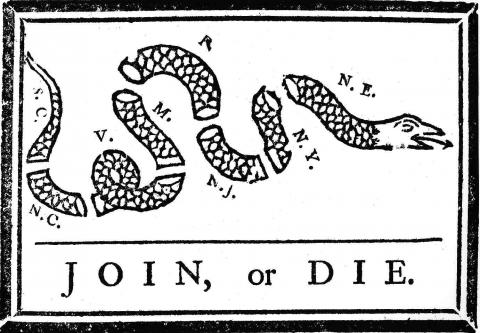The 'Join or Die' Cartoon
One of Benjamin Franklin’s most famous creations was the political cartoon “Join, or Die.” The oldest known illustration of colonial union in America, the cartoon first appeared as a woodcut and then later in print, in the Pennsylvania Gazette on May 9, 1754. Franklin, an influential citizen and statesman, came up with the idea of urging the 13 Colonies to unite behind England in its struggle against the French and Native American forces during the French and Indian War. An urban legend had it that a snake cut into pieces could come alive again if those pieces were reunited before sunset.
Existing colonies not represented in the illustration were Delaware, which shared a governor with Pennsylvania, and Georgia, which had, up to that time, played little part in the goings-on leading up to the war. Also appearing in that edition of the Pennsylvania Gazette was an editorial by Franklin, urging the colonists to unite and making the argument that strength came from numbers and common purpose. Among other things, Franklin argued that "present disunited State of the British Colonies" would enable the French and Native American allies to "take an easy Possession of such Parts of the British Territory as they find most convenient for them" and that a joint French-Native American success "must end in the Destruction of the British interest; Trade and Plantations in America." Franklin’s arguments formed the basis of the Albany Plan, a strategy for a unified government put forward at the Albany Congress on the day following the publication of the cartoon and editorial. Franklin’s urgings played a role in helping many colonists decide which side to support in the war. Most colonists who took up arms during the war, including George Washington,fought on the British side. Great Britain eventually won the war, in 1763. Complications of the peace, including disagreements over how to pay for the costs of that war, led to a series of events that eventually led to the American War of Independence. Just two years after the end of the French and Indian War, Americans were again up in arms, politically, over the Stamp Act. At the subsequent Stamp Act Congress, colonists returned to Franklin’s “Join, or Die” idea and applied it to the then-current situation, urging the colonies to unite again, this time against Great Britain. Franklin wasn’t all that happy about the use of his cartoon in this new way, preferring a new and different illustration of the need for unity, but the appeal of the image in support of the new calls for union was irresistible to many in America. The cartoon appeared again in newspapers up and down the Eastern Seaboard, sometimes week after week for sveral months. Noted revolutionary Paul Revere even incorporated it into the masthead of the Massachusetts Spy, in 1774. By that time, the snake had acquired a “G” for Georgia. |
|
Social Studies for Kids
copyright 2002–2025
David White



 The snake in Franklin’s illustration has eight pieces. The piece containing the head is labelled N.E., for New England, and represented Connecticut, Massachusetts, New Hampshire, and Rhode Island. Moving down toward the tail, the pieces represented New York, New Jersey, Pennsylvania, Maryland, Virginia, North Carolina, and South Carolina.
The snake in Franklin’s illustration has eight pieces. The piece containing the head is labelled N.E., for New England, and represented Connecticut, Massachusetts, New Hampshire, and Rhode Island. Moving down toward the tail, the pieces represented New York, New Jersey, Pennsylvania, Maryland, Virginia, North Carolina, and South Carolina.

